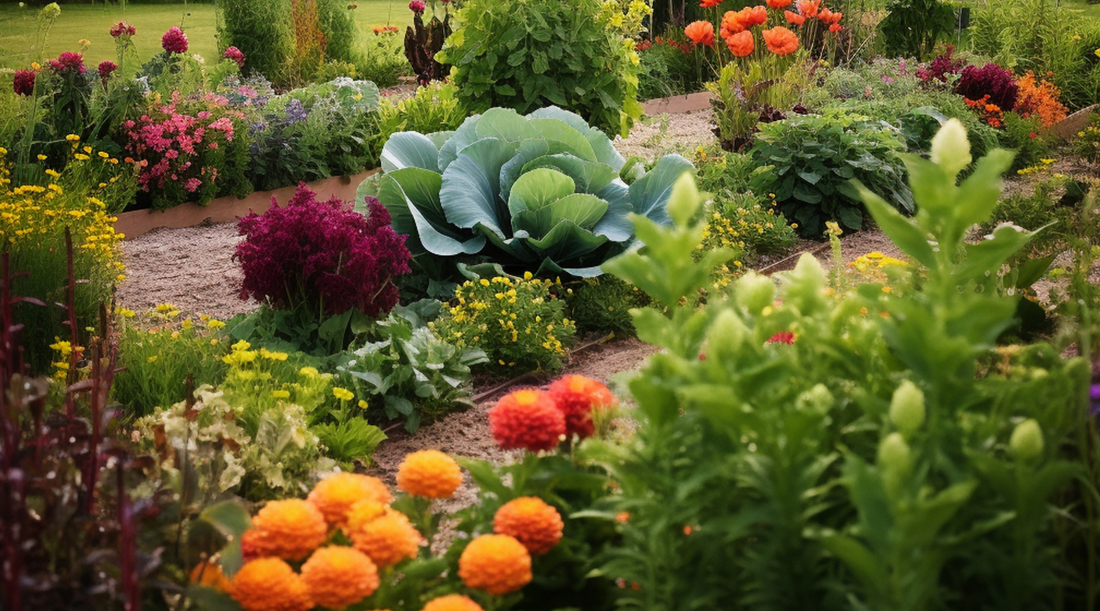
Garden Aesthetics and Design: A Deep Dive into Nature's Art
Gardening isn't just about planting and watching seeds grow; it's about designing a living artwork that delights the senses and nurtures the soul. Garden aesthetics and design is an intricate blend of nature, art, and science. They are vibrant expressions of art, personality, and philosophy. A well-designed garden can be aesthetically pleasing, a feast for the eyes, and a testament to the harmonious collaboration of nature and human touch.
In this article, we'll explore the foundations of garden aesthetics and provide insights into crafting a beautiful and functional garden. Let's embark on an insightful journey through the lush tapestry of garden aesthetics and design.
Historical Evolution of Garden Aesthetics
Garden designs have profoundly transformed from ancient Egypt's precisely laid-out gardens to Victorian England's sprawling green expanses.
- Ancient garden designs: The Hanging Gardens of Babylon, considered one of the Seven Wonders of the Ancient World, exemplify the desire for structural beauty. Egyptian gardens, too, were mainly utilitarian, often centered around a pool, and the design ensured shade and cooling.
- Renaissance gardens: These were often seen as an extension of the home. Symmetry became prominent, and water features, from simple fountains to cascading terraces, marked the gardens of this era.
- Oriental gardens: In stark contrast, Japanese Zen gardens focused on creating harmony. Every rock and sand pattern was designed to cultivate inner peace and reflection, emphasizing minimalism.
Understanding the Principles of Design
At the heart of every memorable garden lies intentionality. A deliberate blend of balance, proportion, emphasis, contrast, rhythm, and movement is crucial. For instance, the famed gardens of Versailles weren’t just “thrown together.” They were meticulously planned, balancing grand, symmetrical designs with natural, flowing elements.
- Balance: Achieving equilibrium in your garden, be it symmetrical or asymmetrical creating a focal point.
- Proportion: Ensuring the sizes of plants, structures, and other elements are harmonious with the overall garden space.
- Emphasis: Highlighting specific points of interest or focal areas.
- Contrast: Using opposing elements to enhance overall interest.
- Rhythm and Movement: Guiding the eye through repetitive patterns or sequences.
Quick Tip: Visualizing your garden in quadrants is a simple way to establish balance. Think about the heights, colors, and textures you have in one quadrant and try to mirror or complement them in the opposite quadrant.
Harnessing the Power of Color: Painting with Nature's Palette
Colors can evoke emotions and set moods. In Japanese gardens, green, which symbolizes eternal life and vitality, is dominant. Paired with the occasional bursts of red or pink - hues representing life and passion - the gardens are alive with energy and tranquility.
- Color Wheel Basics: How to use complementary, analogous, and triadic color schemes.
- Mood Setting with Colors: Utilizing color to evoke specific emotions or atmospheres. Blending bright colors and dark colors create interest and prevent monotony.
- Seasonal Color Palette: Designing for color. Japanese maples are popular for dynamic garden design due to their beautiful fall color.
Research has shown that greenery can be calming, reducing stress levels. So, populating your garden with green, be it from foliage or grass and flowering plants can be an invitation to serenity and natural environment.
Texture and Form
Every plant brings its unique texture and form. The sleek lines of bamboo contrast beautifully with the ruffled blossoms of peonies. This variance is what makes a beautiful garden and landscape design visually intriguing.
- Visual Textures: From the velvety petals of roses to the spiky leaves of succulents creating a focal points.
- Form and Silhouette: The shapes of plants and how they contribute to the garden's overall look adds a visual interest.
Idea to Ponder: Studies suggest that touching diverse natural textures can enhance our connection to the environment.
Integrating Nature and Sustainability
Sustainability isn’t a trend; it’s a necessity. Native planting isn't just about preserving local ecosystems. Native plants often require less water and fewer pesticides, leading to eco-friendly gardens.
A study in North Carolina revealed that native plants used 83% less water than their non-native counterparts.
The Sensory Experience
Gardens are a sensory delight, from the intoxicating scent of jasmine on a summer night to the melodic chirping of crickets. Gardens designed for the visually impaired focus heavily on sensory stimulation, emphasizing fragrant plants and textured pathways.
- Fragrance Gardens: Choose plants like lavender, rose, and jasmine, they add aroma while adding visual interest to your garden design.
- Soundscapes: Incorporating elements that create soothing sounds, such as rustling grasses or water features.
- Tactile Plants: Plants that are a joy to touch, like soft lamb's ears or rough bark.
The next time you're in your garden, close your eyes. What do you hear, smell, or feel? This exercise can be a revelation in sensory appreciation.
Seasonal Changes and Succession Planting
A garden’s story evolves with the seasons. Cherry blossoms might herald spring, but the russet tones of maple leaves narrate autumn tales. By planning for year-round interest, you're ensuring your garden has a dynamic, ever-evolving storyline.
A Garden is a book that’s written anew each year. Become its author, and pen a narrative filled with seasonal wonder.
Garden Themes and Styles
- Traditional Vs. Contemporary Gardens: Exploring various design themes from the classic English garden to minimalist Zen gardens.
- Themed Gardens: Ideas like butterfly gardens, moonlight gardens, or edible landscapes.
Incorporating Elements of Nature
Nature has its language, and the most enchanting gardens let nature speak.
- Water: A pond can mirror the sky, making a small garden feel expansive. Moving water, like in streams or waterfalls, can introduce sound, creating a garden feel lively and vibrant. One of the most popular garden designs is the pond garden, which features a naturally occurring or man-made pond as its focal point.
- Stones and Rocks: In Japan, rocks represent islands and are used in gardens to symbolize spiritual journeys.
- Plants: There's a psychological component to plant selection. For instance, lavender is not only beautiful but is also known to reduce anxiety and enhance calmness.
Modern Garden Design Trends
Our fast-paced world is shaping our gardens, too.
- Minimalist gardens reflect our current societal shift towards simplicity and decluttering, both physically and mentally.
- Urban gardens: Green rooftops and balcony gardens are becoming a breath of fresh air in concrete jungles and adds aesthetic appeal. They optimize limited spaces and also help combat the urban heat island effect.
- Edible gardens: The farm-to-table movement has people growing vegetables and herbs, merging beauty with utility.
The Profound Impact of Garden Design: Beyond Aesthetics
1. Psychological Well-being
Gardens are sanctuaries for the mind. How a garden is designed can become a calming oasis or a chaotic, stressful space.
- Healing gardens: These are thoughtfully designed to promote better health outcomes. Studies have shown that well-designed gardens in hospital settings can significantly reduce patient recovery time.
- Mindfulness and meditation: Modern gardens are increasingly designed with meditation spaces, fostering mindfulness and grounding.
2. Environmental Impact
How we design our gardens plays a pivotal role in the well-being of our planet.
- Biodiversity: A garden rich in diverse plants can become a habitat for various species of insects, birds, and other fauna. By contrast, monotonous gardens may offer little ecological value.
- Water conservation: Opting for drought-resistant or native plants adapted to the local climate can drastically reduce water usage.
- Urban temperature control: In congested cities, green spaces, especially those with canopy trees, can help mitigate the urban heat island effect, making cities cooler.
3. Social Dynamics
Gardens can act as communal spaces, fostering interaction, community, and a sense of belonging.
- Community gardens: These shared spaces bring fresh produce to urban dwellers and foster community spirit, collaboration, and education about sustainable practices.
- Educational hubs: Schools with well-designed gardens can become hands-on ecological classrooms, fostering a love for nature in young minds.
4. Economic Aspects
While often overlooked, the design of a garden can significantly impact property value and local economies.
- Property value: Houses with well-maintained gardens typically have a higher market value. According to the Journal of Landscape and Urban Planning, a well-landscaped garden can increase a property's value by up to 12%.
- Tourism: Iconic gardens, like the Butchart Gardens in Canada or Kew Gardens in the UK, draw thousands of tourists yearly, boosting local economies.
5. Cultural Expression
Gardens are reflections of cultural values, histories, and artistic expressions.
- Historical gardens: Places like the Persian or French formal gardens encapsulate their times' ethos, values, and aesthetics.
- Personal expression: On a micro scale, every individual's garden is a canvas of personal tastes, memories, and experiences
Challenges and Solutions in Garden Design
With global challenges like climate change and urban crowding, garden design is adapting.
- Climate adaptation: Gardens in drier areas are transitioning towards drought-resistant plants. Xeriscaping, a landscaping philosophy that minimizes water use, is becoming popular in arid regions.
- Maintenance: Perennial plants, which live for more than two years, are becoming a staple in modern gardens due to their low maintenance needs.
Conclusion
Gardens, much like art, are never truly finished. They evolve, grow, and change. Embracing this fluidity and understanding that a garden's dynamic design is essential. After all, the beauty of a garden lies not just in its aesthetics but in its ever-changing nature and the joy of the journey.
Crafting a garden with deliberate aesthetics and design isn't just about beauty. It's about creating a sanctuary, a personal retreat, and a space that resonates with the gardener's soul. With thought, care, and creativity, any plot of land can be transformed into a living masterpiece.
Gardening is a journey of discovery, creativity, and connection. As we cultivate our plots, we also cultivate our understanding of life, aesthetics, and nature's intricate dance. Every garden, regardless of its size or location, has the potential to be a masterpiece, a living testament to the harmonious blend of nature and nurture.
